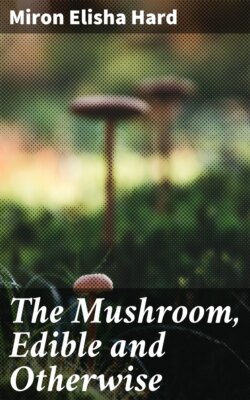Читать книгу The Mushroom, Edible and Otherwise - Miron Elisha Hard - Страница 6
На сайте Литреса книга снята с продажи.
CHAPTER I.
ОглавлениеTable of Contents
WHY STUDY MUSHROOMS. Some years ago, while in charge of the schools of Salem, Ohio, we had worked up quite a general interest in the study of botany. It was my practice to go out every day after flowers, especially the rarer ones, of which there were many in this county, and bring in specimens for the classes. There was in the city a wire nail mill, running day and night, whose proprietors brought over, from time to time, large numbers of Bohemians as workers in the mill. Very frequently, when driving to the country early in the morning, I found the boys and girls of these Bohemian families searching the woods, fields and pastures at some distance from town, although they had not been in this country more than a week or two and could not speak a word of English. I soon found that they were gathering mushrooms of various kinds and taking them home for food material. They could not tell me how they knew them, but I quickly learned that they knew them from their general characteristics—in fact, they knew them as we know people and flowers.
I resolved to know something of the subject myself. I had no literature on mycology, and, at that time, there seemed to be little obtainable. About that time there appeared in Harper's Monthly an article by W. Hamilton Gibson upon Edible Toadstools and Mushrooms—an article which I thoroughly devoured, soon after purchasing his book upon the subject.
Salem, Ohio, was a very fertile locality for mushrooms and it was not long till I was surprised at the number that I really knew. I remembered that where there is a will there is a way.
In 1897 I moved to Bowling Green, Ohio; there I found many species which I had found about Salem, Ohio, but the extremely rich soil, heavy timber and numerous old lake beaches seemed to furnish a larger variety, so that I added many more to my list. After remaining three years in Bowling Green, making delightful acquaintance with the good people of that city as well as with the flowers and mushrooms of Wood county, Providence placed me in Sidney, Ohio, where I found many new species of fungi and renewed my acquaintance with many of those formerly met.
Since coming to Chillicothe I have tried to have the plants photographed as I have found them, but having to depend upon a photographer I could not always do this. I have not found in this vicinity many that I have found elsewhere in the state, although I have found many new things here, a fact which I attribute to the hilly nature of the county. For prints of many varieties of fungi obtained before coming here, I am indebted to my friends. I should advise any one intending to make a study of this subject to have all specimens photographed as soon as they are identified, thus fixing the species for future reference.
It seems to me that every school teacher should know something of mycology. Some of my teachers have during the past year made quite a study of this interesting subject, and I have found that their pupils kept them busy in identifying their finds. Their lists of genera and species, as exhibited on the blackboards at the close of the season were quite long. I found from my Bohemian boys and girls that their teachers in their native country had opened for them the door to this very useful knowledge. Observation has proven to me conclusively that there is a large and increasing interest in this subject throughout the greater part of Ohio.
Every professional man needs a hobby which he may mount in his hours of relaxation, and I am quite sure there is no field that offers better inducement for a canter than the subject of botany, and especially this particular department of botanical work.
I have a friend, a professional man who has an eye and a heart for all the beauties of nature. After hours of confinement in his office at close and critical work he is always anxious for a ramble over the hillsides and through the woods, and when we find anything new he seems to enjoy it beyond measure.
Many ministers of the gospel have become famous in the mycological world. The names of Rev. Lewis Schweiwitz, of Bethlehem, Pa.; Rev. M. J. Berkeley and Rev. John Stevenson, of England, will live as long as botany is known to mankind. Their influence for good and helpfulness to their fellowmen will be everlasting.
With such an inspiration, how quickly one is lost to all business cares, and how free and life-giving are the fields, the meadows and the woods, so that one must exclaim with Prof. Henry Willey in his "Introduction to the Study of the Lichen":
"If I could put my woods in song,
And tell what's there enjoyed,
All men would to my garden throng,
And leave the cities void.
In my lot no tulips blow;
Snow-loving pines and oaks instead;
And rank the savage maples grow,
From Spring's first flush to Autumn red;
My garden is a forest ledge,
Which older forests bound."
